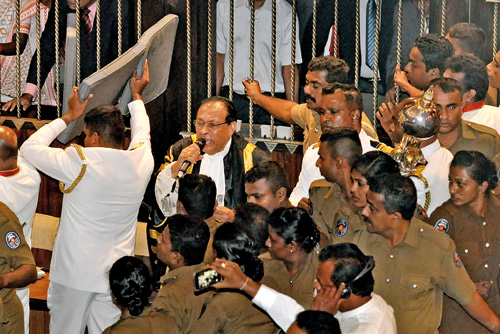News
2018: Politics steals the show for all the wrong reasons
An unprecedented constitutional crisis plunged the country into political and economic turmoil for almost two months this year, with the matter eventually being settled by the country’s highest court.

The Speaker under attack: One of the many ugly scenes that erupted in Parliament
The crisis began on the evening of Friday, October 26 and took much of the country entirely unawares with President Maithripala Sirisena sacking incumbent Prime Minister Ranil Wickremesinghe and installing former President Mahinda Rajapaksa in his place. The move precipitated a period of uncertainty and chaos, with a defiant Mr. Wickremesinghe challenging the President’s move and refusing to vacate Temple Trees, the Prime Minister’s official residence.
Matters turned ugly when the President prorogued Parliament, amidst allegations that parliamentarians were being offered hundreds of millions of rupees to cross over in a bid to ensure that the Sirisena-Rajapaksa alliance had a majority in Parliament.
In another shocking move, the President dissolved Parliament via an extraordinary gazette notification effective from midnight, on Friday, November 9. The move was challenged in the Supreme Court by more than a dozen petitioners. A three-judge Supreme Court bench headed by Chief Justice Nalin Perera issued an interim order suspending the gazette notification and gave leave to proceed.
With Parliament reconvening following the stay order, two No-Confidence motions were passed against the Rajapaksa Government on November 14 and 16 amid chaotic scenes, with Speaker Karu Jayasuriya having to be escorted to the chamber under police guard on the 16th. The chaos in Parliament saw MPs throwing chilli powder, pieces of furniture and other missiles at police officers guarding the Speaker, while one MP was seen carrying an object resembling a knife.
On December 3, following a quo warranto writ petition filed by 122 MPs, the Court of Appeal issued an interim order restraining Mahinda Rajapaksa from functioning as PM, and others in the Cabinet from functioning as State and Deputy Ministers.
On December 13, in a landmark decision a seven-member SC bench led by Chief Justice Perera unanimously ruled the President’s decision to dissolve parliament was unconstitutional. In a final blow to Mr Rajapaksa, the following day, the SC rejected his appeal to overturn the Court of Appeal’s interim order but agreed to proceed with the case.
With Mr Rajapaksa formally submitting his resignation on December 15, Mr Wickremesinghe was sworn in again as PM the following day, signalling an end to the seven-week crisis.

